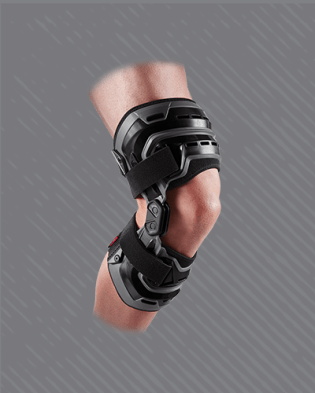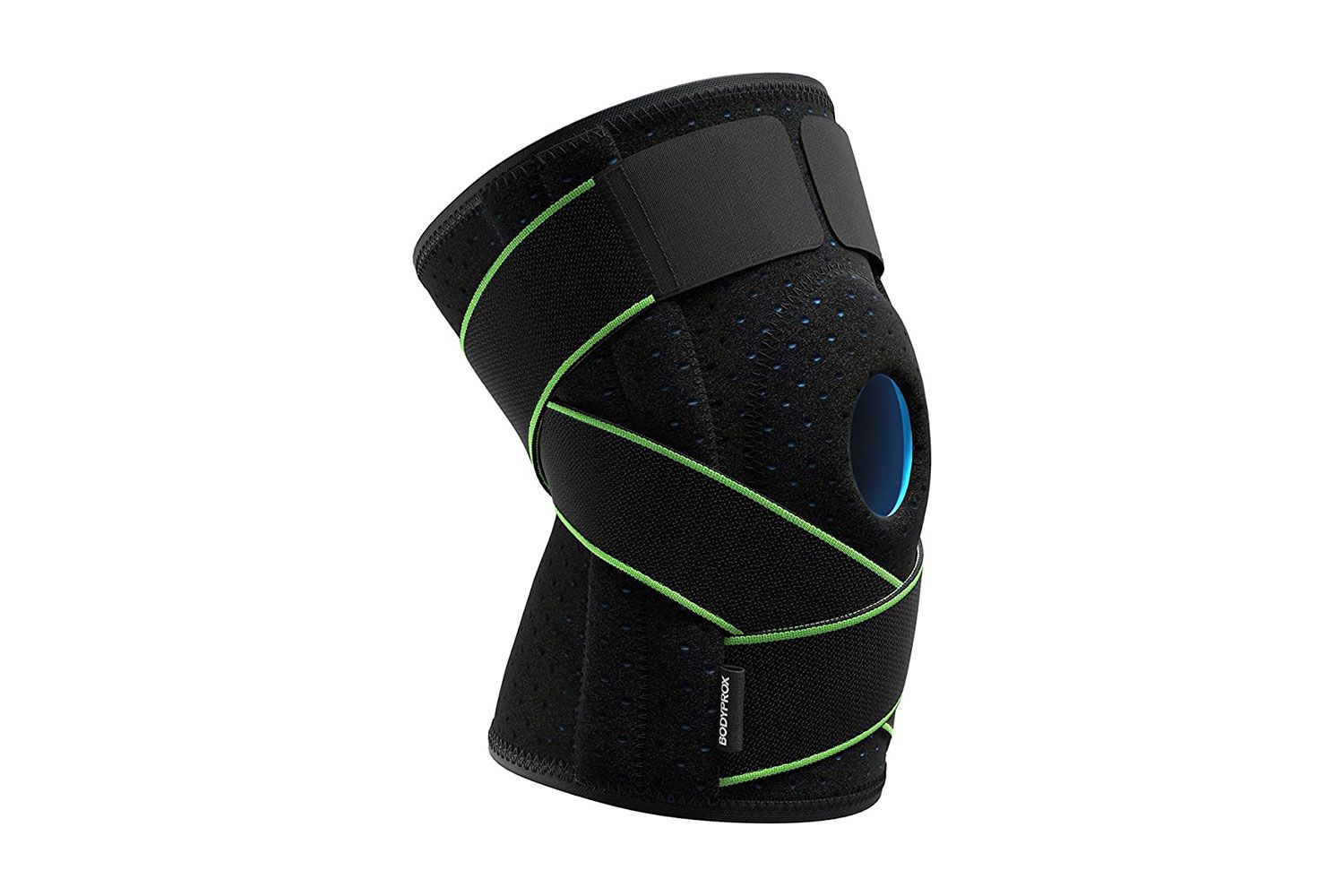In this article, you will learn about the future of knee braces in 2023. We will explore the advancements in technology, materials, and design that are shaping the development of knee braces. Additionally, we will discuss the potential benefits for athletes, individuals with knee injuries, and those seeking preventive measures. By the end, you will have a better understanding of how knee braces are evolving to provide improved support and comfort for a wide range of individuals.
What are Knee Braces?
Knee braces are medical devices designed to provide support and stability to the knee joint. They are commonly used to prevent and treat injuries, as well as to aid in the rehabilitation process. Knee braces come in different types, each serving a specific purpose depending on the severity of the injury or the condition being treated.
Different types of knee braces
There are several types of knee braces available in the market today. The three most common ones are hinged knee braces, patellar stabilizing knee braces, and neoprene knee sleeves.
Hinged knee braces are considered the most supportive and are often used for moderate to severe knee injuries. They have metal hinges on both sides of the knee, which provide lateral stability and control the flexion and extension movements of the joint.
Patellar stabilizing knee braces, as the name suggests, are designed to stabilize the patella or kneecap. They have a circular opening in the front, surrounding the patella, to provide support and prevent misalignment.
Neoprene knee sleeves are the most basic type of knee braces. They are made of a stretchy and breathable material called neoprene, which provides compression and warmth to the knee joint. Neoprene sleeves are commonly used for mild knee pain, arthritis, or as a preventive measure during physical activities.
How knee braces work
Knee braces work by providing the necessary support and stability to the knee joint. They help to ease pain, reduce inflammation, and prevent further injuries. The specific mechanism of action depends on the type of knee brace being used.
Hinged knee braces, with their metal hinges, restrict the movement of the knee joint, preventing it from bending or extending too far. They also provide stability to the joint, minimizing the risk of further injury.
Patellar stabilizing knee braces hold the patella in proper position and alignment. They reduce the pressure on the patellar ligament and ensure that the kneecap moves smoothly within its groove during movement.
Neoprene knee sleeves offer compression and warmth to the knee joint, which helps to improve blood circulation, reduce swelling, and alleviate pain. They also provide proprioceptive feedback, improving the user’s balance and awareness of their knee position.
Benefits of using knee braces
Using knee braces can offer several benefits, depending on the injury or condition being treated. Some of the key advantages include:
-
Increased stability and support: Knee braces provide added stability to the knee joint, reducing the risk of further injury. They offer support to weak or injured ligaments and muscles, helping the joint to function properly.
-
Pain relief: Knee braces can help alleviate pain by reducing pressure on the affected area, improving blood circulation, and providing compression and warmth to the joint.
-
Injury prevention: Knee braces are commonly used as a preventive measure during physical activities that involve repetitive movements or high impact on the knee joint. They can help protect the knee from strains, sprains, and other injuries.
-
Rehabilitation aid: Knee braces play a crucial role in the rehabilitation process following an injury or surgery. They can support the joint during exercises and physical therapy, helping to rebuild strength and stability.
-
Improved performance: Athletes and active individuals often use knee braces to enhance their performance and reduce the risk of injuries. The added stability and support provided by the braces can improve their confidence and enable them to perform at their best.
When to Use Knee Braces?
Knee braces can be used in a variety of scenarios, either to prevent injuries or to aid in recovery from existing injuries. Understanding when to use knee braces is important in order to get the maximum benefit from them.
Common injuries requiring knee braces
Knee braces are commonly used to treat and prevent injuries such as:
-
Ligament sprains: Knee braces can be effective in treating mild to moderate ligament sprains, such as a medial collateral ligament (MCL) or lateral collateral ligament (LCL) sprain. They provide support to the injured ligament, allowing it to heal properly.
-
Meniscus injuries: A torn meniscus is a common knee injury, especially among athletes. Knee braces can help stabilize the knee joint and provide relief during the healing process.
-
Patellar dislocations: Patellar stabilizing knee braces are commonly used to prevent the dislocation or subluxation of the kneecap. They hold the patella in place and prevent it from sliding out of position.
-
Anterior cruciate ligament (ACL) injuries: In cases of an ACL tear or rupture, knee braces are often used post-surgery to provide support and stability to the knee joint during the rehabilitation process.
Medical conditions where knee braces are recommended
In addition to injuries, knee braces are also recommended for certain medical conditions, including:
-
Osteoarthritis: Knee braces can provide relief from pain and discomfort caused by osteoarthritis by reducing pressure on the knee joint and improving stability.
-
Patellofemoral pain syndrome: This condition, also known as runner’s knee, causes pain in the front of the knee. Patellar stabilizing knee braces can help alleviate the pain and prevent further damage.
-
Patellar tendinitis: Also known as jumper’s knee, this condition is characterized by inflammation of the patellar tendon. Knee braces provide compression and support to the tendon, reducing pain and promoting healing.
-
Post-surgical rehabilitation: Knee braces are commonly used after knee surgeries, such as ACL reconstruction or meniscus repair, to provide support and protect the joint during the recovery period.
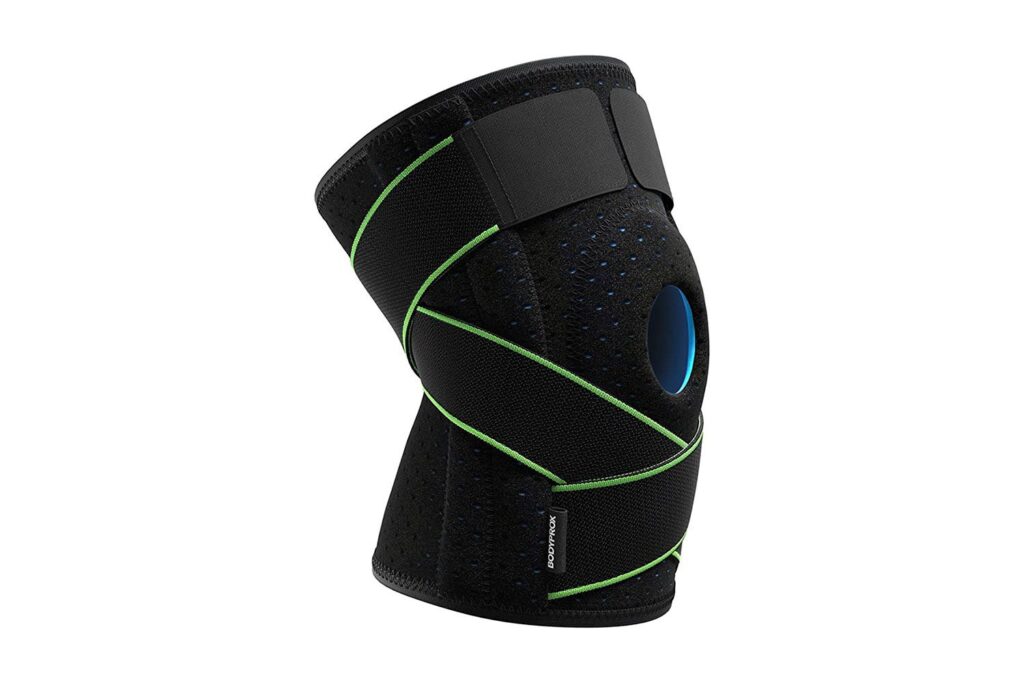
Choosing the Right Knee Brace
Choosing the right knee brace is essential to ensure optimal support and functionality. There are several factors to consider when selecting a knee brace:
Factors to consider when selecting a knee brace
-
Type of injury or condition: The type and severity of the injury or condition should determine the type of knee brace to use. Consult a healthcare professional for guidance and recommendations.
-
Level of support required: Different knee braces offer varying levels of support. Consider how much stability and support your knee needs and choose a brace accordingly.
-
Size and fit: Knee braces come in different sizes, so it is important to measure your knee accurately to ensure a proper fit. An ill-fitting knee brace may not provide the necessary support and can cause discomfort.
-
Activity level: Consider your activity level and the type of movements involved. Some knee braces are designed for specific activities, such as sports or jogging. Choose a brace that suits your lifestyle and preferences.
Consulting a healthcare professional for guidance
It is always recommended to consult a healthcare professional, such as a physician or a physical therapist, before selecting a knee brace. They can provide a comprehensive assessment of your injury or condition and recommend the most suitable knee brace for your needs.
A healthcare professional can also guide you on how to wear the knee brace properly, explain any limitations or precautions, and suggest additional treatments or exercises to complement the use of the brace.
Proper Fit and Usage
Proper fit and usage of knee braces are crucial for their effectiveness. Here are some guidelines to ensure a proper fit and maximize the benefits of using knee braces:
How to properly measure for a knee brace
Measuring for a knee brace should be done with care to ensure accuracy. Here is a step-by-step guide:
- Measure the circumference of your thigh, above the knee joint, at its widest point.
- Measure the circumference of your calf, below the knee joint, at its widest point.
- Measure the length of your lower leg, from the center of your kneecap to the bottom of your shin.
Use these measurements as a guide when selecting the appropriate size of knee brace. Refer to the manufacturer’s sizing chart to determine the correct size based on your measurements.
Wearing instructions for different types of knee braces
Each type of knee brace comes with specific wearing instructions. It is important to follow these instructions to ensure proper usage and effectiveness. Here are some general guidelines:
-
Hinged knee braces: Place the hinged knee brace on your leg with the metal hinges on both sides of your knee. Secure the straps or closures to ensure a snug fit. Adjust the hinges to allow for the desired range of motion or restrict it as advised by your healthcare professional.
-
Patellar stabilizing knee braces: Slip the knee brace over your leg, with the circular opening positioned over your kneecap. Fasten any straps or closures to secure the brace in place. Ensure that the kneecap is centered within the opening for proper alignment and support.
-
Neoprene knee sleeves: Slide the neoprene knee sleeve onto your leg, positioning it snugly over your knee joint. Make sure it covers the full knee area. Neoprene knee sleeves can be worn throughout the day or during physical activities for added support and compression.
Proper care and maintenance of knee braces
To ensure the longevity and effectiveness of knee braces, proper care and maintenance are essential. Here are some tips:
-
Regular cleaning: Depending on the material, knee braces may need to be hand-washed or machine-washed to remove sweat, dirt, and odor. Follow the manufacturer’s instructions for cleaning.
-
Drying: Allow the knee braces to air dry completely before storing them. Avoid exposing them to direct heat or sunlight, as it can damage the material.
-
Inspection: Regularly inspect the knee braces for any signs of wear and tear. Check the straps, closures, or hinges for proper functioning. If any part of the knee brace is damaged or not functioning as intended, consider replacing it.
-
Storage: Keep knee braces in a dry and clean place when not in use. Avoid bending or folding them excessively, as it can affect their shape and functionality.
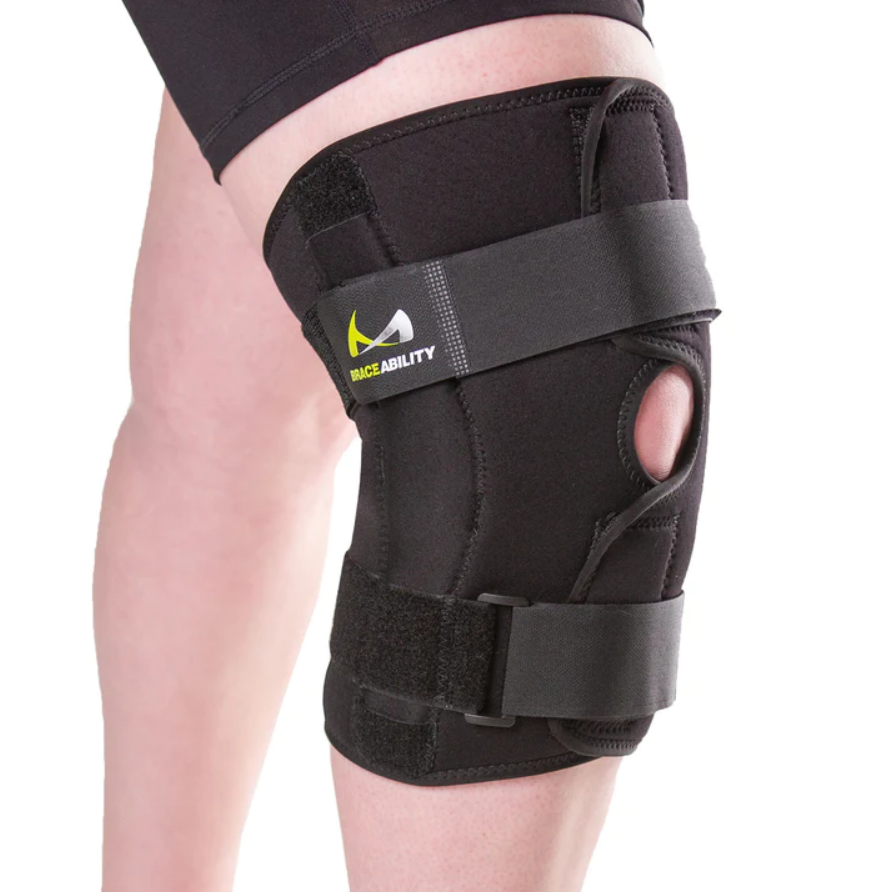
Common Knee Brace Types
Understanding the different types of knee braces can help in choosing the right one for your needs. Here are the three most common knee brace types:
Hinged knee braces
Hinged knee braces offer maximum support and stability to the knee joint. They are commonly used for moderate to severe knee injuries, such as ligament sprains or ACL tears. Hinged knee braces have metal hinges on both sides of the knee, allowing controlled movement and preventing excessive bending or extension of the joint. They provide lateral support and help prevent further injury.
Patellar stabilizing knee braces
Patellar stabilizing knee braces are specifically designed to stabilize the kneecap and prevent it from dislocating or subluxating. These braces have a circular opening in the front, surrounding the patella, providing support and alignment. They help to distribute pressure evenly on the patellar tendon, reducing pain and promoting proper patellar tracking.
Neoprene knee sleeves
Neoprene knee sleeves are the most basic type of knee braces. They are made of a stretchy and breathable material called neoprene, which provides compression, warmth, and support to the knee joint. Neoprene knee sleeves are commonly used for mild knee pain, arthritis, or as a preventive measure during physical activities. They offer moderate support and can improve blood circulation, reducing swelling and discomfort.
Preventing Knee Injuries
Taking preventive measures can help maintain knee health and reduce the risk of injuries. Here are some exercises, stretches, and tips to strengthen knee muscles and prevent knee injuries:
Exercises and stretches to strengthen knee muscles
-
Quadriceps exercises: Strengthening the quadriceps muscles can provide support and stability to the knee joint. Exercises such as squats, lunges, and leg presses can help strengthen these muscles.
-
Hamstring exercises: Strong hamstrings are vital for knee stability. Exercises like hamstring curls and deadlifts can help strengthen these muscles.
-
Calf raises: Strong calf muscles can help absorb shock and reduce stress on the knees. Perform calf raises to strengthen the calf muscles.
-
Balance exercises: Improving balance can help prevent knee injuries. Try exercises like single-leg stands or using a balance board or stability ball to challenge your balance.
-
Stretching: Regular stretching exercises can help improve flexibility and range of motion in the knee joint. Stretching the quadriceps, hamstrings, and calf muscles can be particularly beneficial.
Tips for maintaining knee health and preventing injuries
-
Maintain a healthy weight: Excess weight puts added stress on the knees, increasing the risk of injury. Maintain a healthy weight to reduce the strain on your knees.
-
Use proper form: When engaging in physical activities or sports, use proper form and technique to avoid unnecessary stress on the knees. Seek guidance from a trainer or coach if needed.
-
Warm-up and cool-down: Always warm up before exercising or engaging in physical activities. A proper warm-up prepares the muscles and joints for activity. Similarly, cool down after exercise to help prevent stiffness and promote recovery.
-
Replace worn-out footwear: Worn-out shoes can affect the alignment and mechanics of the knees, increasing the risk of injury. Regularly replace your footwear to ensure proper support and cushioning.
-
Listen to your body: Pay attention to any discomfort or pain in your knees. If you experience persistent pain or notice any swelling or instability, seek medical attention promptly. Ignoring symptoms can lead to further damage and complications.

Recovering from Knee Injuries
Recovering from knee injuries can be a challenging process, but knee braces can play a significant role in aiding the recovery. Here are some ways knee braces can assist in the rehabilitation process:
Post-injury rehabilitation using knee braces
Following an injury, knee braces are often used during the rehabilitation process to provide support, stability, and protection to the knee joint. They help to control the range of motion, prevent excessive movement, and reduce strain on the injured tissues.
Knee braces can be particularly beneficial during the initial stages of rehabilitation, when the injured ligaments or tissues are healing. They provide a sense of security and confidence to the user, allowing them to engage in rehabilitation exercises and activities with reduced pain and risk of further injury.
Physical therapy exercises for knee recovery
Physical therapy exercises are an essential part of knee recovery. A physical therapist can design a personalized rehabilitation program that includes exercises to strengthen the muscles around the knee, improve flexibility, and restore joint function.
Some common physical therapy exercises for knee recovery include:
-
Range of motion exercises: These exercises help improve the flexibility and mobility of the knee joint, restoring full motion. Examples include heel slides, terminal knee extensions, and knee bends.
-
Strengthening exercises: Strengthening the muscles around the knee can provide support and stability. Exercises that target the quadriceps, hamstrings, calves, and hip muscles are commonly prescribed.
-
Balance and stability exercises: These exercises focus on improving balance, proprioception, and coordination to prevent falls and re-injury. They can include single-leg stands, balance board exercises, and functional movements.
-
Plyometric exercises: As the knee strengthens, plyometric exercises can be gradually introduced to improve power and agility. Examples of plyometric exercises for the knees include jumping exercises, lateral hops, and box jumps.
Physical therapy exercises should be performed under the guidance of a qualified professional. It is important to follow the prescribed program, gradually increasing the intensity and difficulty as advised by the physical therapist.
Research and Developments in Knee Braces
The field of knee braces continues to witness advancements and developments, driven by ongoing research and technological innovations. Here are some of the latest advancements and potential future developments in knee brace technology:
Latest advancements in knee brace technology
-
Lightweight materials: Advances in material science have led to the development of lightweight yet durable materials for knee braces. These materials offer improved comfort and breathability without compromising on support and stability.
-
Smart braces: The integration of sensor technology and data analytics in knee braces is an emerging advancement. Smart knee braces can track movement, monitor joint angles, and provide real-time feedback to users and healthcare professionals. This technology has the potential to enhance rehabilitation outcomes and minimize the risk of re-injury.
-
Customized braces: With the help of advances in 3D scanning and printing technology, customized knee braces are becoming more accessible. These braces are designed specifically for an individual’s unique anatomy, providing a better fit and improved performance.
Potential future developments in knee braces
-
Regenerative therapies: Researchers are exploring the use of regenerative therapies, such as stem cell treatments and tissue engineering, to aid in the repair and regeneration of damaged knee tissues. These therapies have the potential to revolutionize the field of knee braces by providing targeted healing and reducing the need for invasive procedures.
-
Biofeedback systems: Biofeedback systems use sensors to provide real-time information about muscle activation, joint alignment, and movement patterns. In the future, knee braces equipped with biofeedback systems may enable users to actively correct their movements and optimize their rehabilitation progress.
-
Artificial intelligence (AI): AI-powered knee braces can analyze and interpret biomechanical data to deliver personalized rehabilitation programs. These braces can adapt and modify the level of support and resistance based on an individual’s progress, optimizing the rehabilitation process.
While these advancements and potential developments show promise, further research and testing are needed before they become widely available.
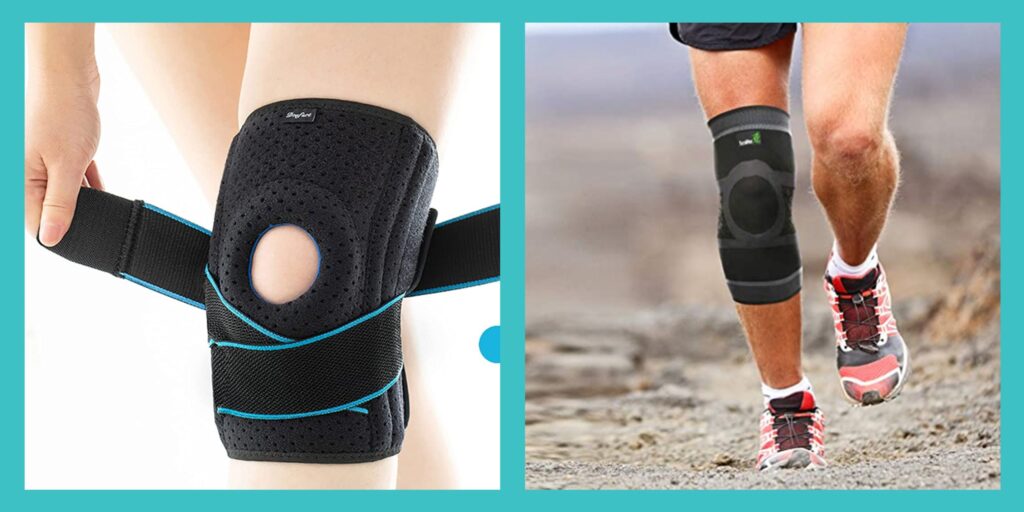
Alternatives to Knee Braces
Although knee braces are effective in preventing and treating injuries, there are alternative options for knee support and pain management. These alternatives should be considered based on individual needs and preferences:
Non-bracing options for knee support
-
Physical therapy: Working with a physical therapist can help improve knee stability and function through targeted exercises and manual techniques. Physical therapy can be a viable alternative to knee braces for certain conditions or injuries.
-
Taping or strapping: Taping or strapping techniques can offer temporary support and relieve pain. Athletic trainers or physical therapists can provide guidance on proper taping techniques based on individual needs.
-
Orthotics or shoe inserts: Custom orthotics or shoe inserts can provide support and correct alignment during walking and running. These devices can help alleviate knee pain caused by biomechanical issues.
Alternative therapies for knee pain management
-
Acupuncture: Acupuncture involves the insertion of thin needles into specific points of the body to relieve pain and promote healing. It can be an alternative treatment for knee pain management, especially for chronic conditions like osteoarthritis.
-
Massage therapy: Massage therapy can help reduce muscle tension, improve circulation, and alleviate pain in the knee and surrounding areas. Various techniques, such as deep tissue massage or myofascial release, can be beneficial in managing knee pain.
-
Transcutaneous electrical nerve stimulation (TENS): TENS therapy involves the use of low-voltage electrical currents to relieve pain. This non-invasive treatment can be used to manage knee pain through the application of electrodes over the affected area.
It is important to note that these alternative options may not be suitable for everyone or may be used in conjunction with knee braces. It is advisable to consult with a healthcare professional to determine the most appropriate treatment plan for individual needs.
Conclusion
Knee braces play a crucial role in injury prevention, treatment, and rehabilitation. They provide support, stability, and pain relief for a range of knee injuries and medical conditions. By choosing the right knee brace, ensuring a proper fit, and following recommended usage guidelines, you can maximize the benefits of using knee braces.
As advancements in knee brace technology continue, we can expect further developments in lightweight materials, smart braces, and customized solutions. These advancements have the potential to enhance rehabilitation outcomes, improve comfort, and optimize knee function. However, it is important to remember that knee braces are not the only option for knee support and pain management. Alternative therapies and non-bracing options can be considered based on individual needs.
The ongoing research and development in the field of knee braces hold promising prospects for the future. Regenerative therapies, biofeedback systems, and AI-powered braces are just a few examples of potential developments that could shape the field. As we look ahead to 2023 and beyond, the importance of knee braces in injury prevention and rehabilitation remains undeniable.
